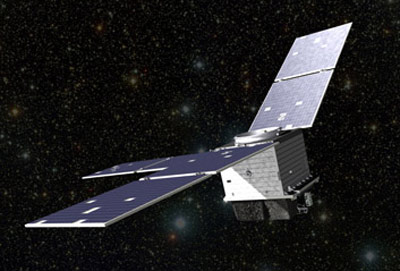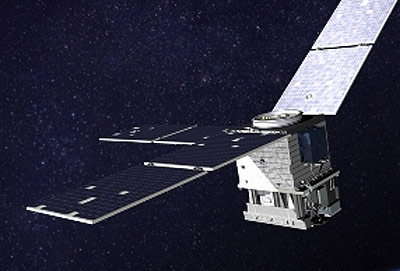Thank you very much for visiting Gunter's Space Page. I hope that this site is useful and informative for you.
If you appreciate the information provided on this site, please consider supporting my work by making a simple and secure donation via PayPal. Please help to run the website and keep everything free of charge. Thank you very much.
STPSat 2, 3

STPSat 2 [Ball]

STPSat 3 [Ball]
STPSat 2 is an experimental spacecraft for STP (Space Test Program). It was the first flight of the Standard Interface Vehicle (STP-SIV).
STPSat-2 carried three experimental payloads that were chosen by the DoD Space Experiment Review Board:
- SPEX (Space Phenomenology Experiment) consisting of two payloads to evaluate sensor compatibility for the space environment
- ODTML (Ocean Data Telemetry MicroSatLink) provides two way data relay from terrestrial (ocean or land) sensors to users (standalone or on the internet).
STPSat 3 is a copy of the STPSat-2 satellite, which carried five experiments, including a module designed to host various space situational awareness sensors and a pair of space environment sensors.
- iMESA-R (Integrated Miniaturized Electrostatic Analyzer Reflight), a U.S. Air Force Academy mission designed to measure plasma densities and energies
- J-CORE (Joint Component Research), a space phenomenology mission sponsored by the Air Force Research Laboratory (AFRL) /EO Countermeasures Technology Branch (RYMW) & Army Space and Missile Defense Command (SMDC)
- SSU (Strip Sensor Unit), an AFRL Directed Energy (RD) experiment to provide risk reduction through on-orbit testing and operation of a sensor assembly
- SWATS (Small Wind and Temperature Spectrometer), a Naval Research Laboratory (NRL) mission to provide in-situ measurements of the neutral and plasma environment to characterize the Earth’s ionosphere and thermosphere
- TCTE (TSI Calibration Transfer Experiment), a NASA/NOAA mission to collect high accuracy, high precision measurements of Total Solar Irradiance to monitor changes in solar irradiance incident at the top the Earth’s atmosphere with TCTE instrument provided by the Laboratory for Atmospheric and Space Physics, originally built as a flight-spare instrument for SORCE.
In addition, the spacecraft has new capability, the MMA Design LLC De-Orbit Module used to de-orbit the satellite in less than 25 years.
| Nation: | USA |
|---|---|
| Type / Application: | Technology |
| Operator: | US Air Force (USAF) STP (Space Test Program) |
| Contractors: | Ball Aerospace (prime); AeroAstro (bus) |
| Equipment: | 2 SPEX, ODTML (#2); iMESA-R, J-CORE, SSU, SWATS, TCTE, De-Orbit Module (#3) |
| Configuration: | Astro-200 |
| Propulsion: | |
| Power: | 3 deployable solar arrays, batteries |
| Lifetime: | 1 year |
| Mass: | 180 kg |
| Orbit: | 641 km × 652 km, 72° |
| Satellite | COSPAR | Date | LS | Launch Vehicle | Remarks | |
|---|---|---|---|---|---|---|
| STPSat 2 (USA 217) | 2010-062A | 20.11.2010 | Kd LP-1 | Minotaur-4 HAPS | with FASTRAC 1, FASTRAC 2, FalconSat 5, FASTSat-HSV 01, RAX 1, O/OREOS, NanoSail-D2, Ballast A, Ballast B | |
| STPSat 3 | 2013-064A | 20.11.2013 | WI LA-0B | Minotaur-1 | with ORS 3, ORSES, ORS Tech 1, ORS Tech 2, SENSE 1, SENSE 2, Ho`oponopono 2, Firefly, STARE B, Prometheus 1.1, ..., 1.8, Black Knight 1, NPS-SCAT, COPPER, ChargerSat 1, TJ3Sat, Trailblazer 1, Vermont Lunar Cubesat, SwampSat, CAPE 2, DragonSat 1, KySat 2, PhoneSat v2.4 |
References:
- AeroAstro: STPSat-2/STP-SIV
Further STP missions:
|
